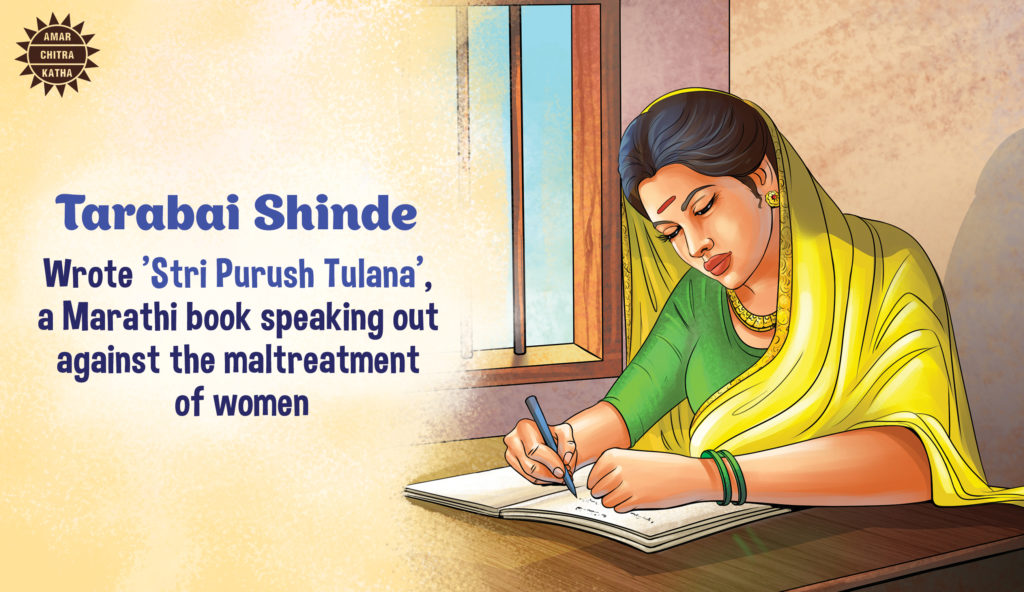By Nainika Nambiar
The 19th century saw a lot of changes in Indian society. It was a time of reform and progress in areas like education, gender equality, caste equality and more. During this phase of promoting an equal society, Tarabai Shinde was one of the very few courageous women who stood up to advocate for equality between the sexes.
Birth and Background
Tarabai was born into an elite Maratha family in the Berar province of Buldana around 1850. Her father, Bapuji Hari Shinde, decided to educate his daughter since she was the only child he had. Therefore, Tarabai was taught Marathi, Sanskrit, and even English. Bapuji was also involved in Jyotirao Phule’s ‘Satyashodhak Samaj’ – otherwise known as the Truth-seeking Society, which was reformist in nature.
Tarabai was eventually married off as a child bride. This was because child marriage was a prominent practice in 19th century India. Fortunately for her, unlike the traditional patrilocal marriages that took place, her wedding had a ‘ghar jamai’ wherein her husband came to live in her house (matrilocality).
Tarabai’s journey with her first and only piece of writing began when she heard of the Vijayalakshmi case in 1881. Vijayalakshmi was a Brahmin widow who had aborted her illegitimate child, and was convicted for the same. After repeated appeals, her death penalty was changed into a sentence of ‘transportation for life’ (banishment or exile).
Soon after, a series of articles were published in the Pune Vaibhar, a prominent newspaper, which criticised and denounced women for having ‘loose morals’. Angered by such a response to the incident, Tarabai decided to write a book against it, called ‘Stri Purush Tulana’.

Stri Purush Tulana
“But do men not suffer from the same flaws that women are supposed to have?”
– Tarabai Shinde
‘Stri Purush Tulana’, written in Marathi, translates to ‘A Comparison between Women and Men’. It was one of India’s first feminist texts. It was published in 1882 but received a hostile response from the readers and was clamped down, remaining unknown for a long time. Eventually, S.G Malshe re-published it in 1975 and the author, Rosalind O’Hanlon, translated it to English in 1994.
The book discusses the maltreatment of women in India, highlighting the gender hierarchies stemming from patriarchy. Tarabai not only rejects this hierarchy, but also challenges it. We see this in the first choice she makes in this text – the title. By placing ‘Stri’ (woman) before ‘Purush’ (man), she has chosen to give women a primary position for a change.
Tarabai critiques how various religious texts have prescribed the ways in which a woman “must” think, act and behave. Her book begins with a paragraph that questions the Gods:
“Let me ask you something, Gods! You are supposed to be omnipotent and freely accessible to all. You are said to be completely impartial. What does that mean? That you have never been known to be partial. But wasn’t it you who created both men and women? Then why did you grant happiness only to men and brand women with nothing but agony? Your will was done! But poor women have had to suffer for it down the ages.”
Her language too is an important influence. Her critique is unfiltered and targets the male population as a major audience. While men called themselves “indestructible”, Tarabai pointed out that they are just as flawed as they consider women to be.
We see an instance of this in how she chooses to point out that society regards adultery as the gravest sin that a woman could commit. Tarabai flips the narrative, holding husbands accountable for failing to keep their wives happy. She further argues that women deserve the right to choose their own husbands to prevent such cases from happening.
The book also advocates for widow remarriage. Tarabai points out how men have been allowed to remarry upon the death of their wives but widows cannot choose to do the same. Seen as an “ill omen”, they are forced to lead an isolated life and abandon all desire to pursue any other romantic or sexual relationship. By being deprived of their ornaments, jewellery and hair, they have been stripped of their sense of “beauty”. When widows do not oblige as expected, they are openly ostracised from mainstream society. We thus see how Tarabai painted a picture of the ruthless double standards that were laid out by society.
Tarabai also openly fights against child marriages as well as caste/income marriages, forced marriages and polygamy. Having lived in a society that has repetitively looked down on prostitutes, she is understanding of their plight. Her method in writing has been to expose the patriarchy, call out the important flaws of its strict rules and show possible solutions wherever applicable.
Influence of Jyotirao Phule
Jyotirao Phule’s ideas had a good amount of influence on Tarabai’s expression of her own ideas. In the year 1854, the Phules began a shelter for upper caste widows who were forbidden from remarriage and ostracised from society. They later involved Tarabai in these initiatives and she became an active participant of the Satyashodhak Samaj.
After the publication of ‘Stri Purush Tulana’, she received harsh criticism. Orthodox communities were appalled and local newspapers published articles that mocked her work. Even Phule’s colleagues, Krishnarao Bhalekar and Narayanrao Lokhande, condemned Tarabai altogether. It was only Jyotirao Phule who took a stand and supported her publicly. He wrote an elaborate article in defence of her critique, which was published in the second issue of the magazine ‘Satsaar’. He addressed her as ‘Chiranjivi’ (daughter) and suggested to his colleagues that they carefully understand her arguments before responding. Phule was beyond proud of her courageous attempt to put forth her views and opinions.
Read about more such inspiring women from Indian history in the title Women Path-Breakers!





